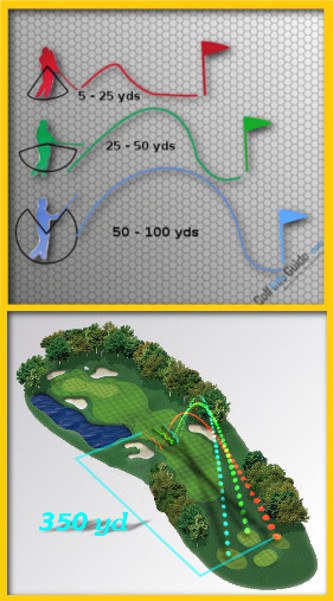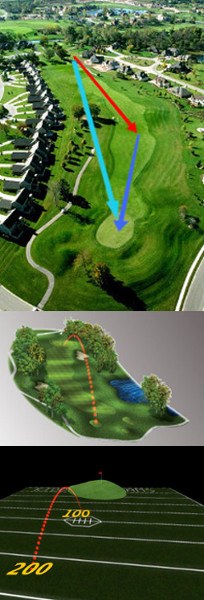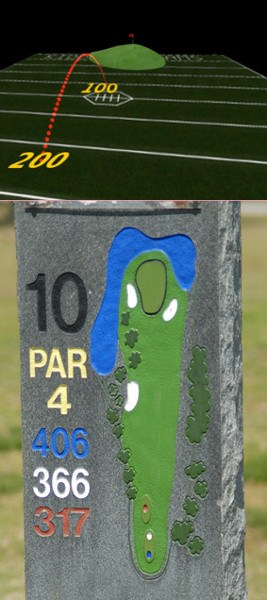
The risk-reward scenario is the essence of golf strategy. Learn to analyze these situations and you'll shave strokes from your scores without making a single swing change.
The risk usually involves hazards (water, sand) or other potential punishment (trees, a tough up-and-down). The reward for taking on the risk is a chance for the golfer to make a better score than he would by playing safely, either short of or around the trouble.
Since each golfer has a different level of risk aversion, there's no right or wrong answer for any given occasion. Here's a checklist for weighing risk-reward situations.
• What is the cost of going for it and failing? Will you pay a severe penalty, or still have a chance to salvage par?
• What is the benefit of succeeding? Do your chances of making par of birdie increase substantially, or just a little?
• How am I swinging today? Is your swing on, or all over the place?
• Do I thrive when being aggressive, or cautious? Not everyone plays safe shots safely.
• What are my chances of success? Is this a shot I've pulled off before, or is it beyond my abilities?
• What's the status of my round? If it's early, there's time to recover from a mistake. If it's late and your score is solid, a conservative play won't cause regret.

Know When to Lay Up and When to Go for It
One of the hardest decisions you have to make on the golf course during any given round is whether to lay up or go for the green on a given shot. Often, this dilemma will be faced when playing a relatively short par five – but you can actually encounter it on any hole, based on the distance of the hole, the wind conditions, your abilities, and more. In many cases, strong arguments can be made in favor of either strategy, so it will be up to you in the end to determine which path is the most likely to lead to success.
For most amateur golfers, the natural tendency is to play an aggressive game. Golf is supposed to be fun after all, right? Why not go for the green and try to pull off an amazing shot which will impress your friends? There is something to be said for that line of thinking, but there is also something to be said for giving yourself the best chance at a good score. At the end of the day, you are likely to remember your final score more than anything else which occurred in the round. Sometimes, going for the green will be the strategy that gives you the greatest chance to conquer the hole. In other cases, however, it is going to be a layup that will serve you best.
In this article, we are going to look at a number of factors which will influence your decision making in this kind of situation. No matter what level of player you happen to be, from a beginner on up to an accomplished pro, deciding whether or not to go for the green is something you will need to do in most rounds. Sometimes, this decision will come up just once during the course of a day. In other rounds, you will have to make this kind of choice over and over again. Prepare yourself ahead of time by thinking about this topic from both sides and you will be more likely to make the right call.
It is important to understand that no matter what decision you wind up making, it is still essential to make an excellent swing. Even if you decide to layup, which is going to feel like an easier shot, you still need to focus yourself and make sure to execute your swing to the best of your ability. No strategy is good enough to overcome a bad golf swing. Once your decision has been made, commit your mind 100% to that decision and forget about the other option that was on the table. You now know what your plan will be, and the only thing left to do is execute that plan perfectly.
All of the content below is based on a right-handed golfer. If you happen to play left-handed, please take a moment to reverse the directions as necessary.

Having a Default Strategy
Before you even walk out onto the golf course, you should already have a default strategy in mind for the day. Most likely, this strategy will not change from day to day. Instead, it will be your standard approach to playing the game. For some golfers, the default plan is to play aggressive at every opportunity. For others, a defensive and strategic game is the preferred approach. Whichever way you go, have a clear strategy in mind which is going to define your general outlook on course management decisions.
Do you have to always adhere to your general strategy? Of course not. No one strategy can properly account for all possible situations. You want to have your basic strategy in mind as a starting point, but you can deviate from that point as the circumstances require. For instance, if you are a conservative player, your plan might be to typically layup on all par fives. However, if you hit a great drive on a downwind hole, you might find that you have less than 200 yards to the green for your second shot. In that case, the proper decision would probably be to go for the green in two, even though that goes against your basic philosophy. The combination of a core strategy with the willingness to adapt on the fly can lead to excellent decision making.
As you are thinking about what kind of default strategy you will use in your own game, it is important to remain true to yourself. In other words, you shouldn't be trying to use a strategy which goes against your own natural personality. Are you a conservative person by nature? If so, playing an aggressive, live-on-the-edge game probably isn't going to work out too well. On the other hand, trying to reign in an aggressive personality by playing a controlled brand of golf will be difficult as well. Think about the way you live off the golf course, and compare that to your strategy on the links. Those two profiles should match up nicely.
The golf you like to play should also make sense for the course or courses where you play the most often. Narrow, tree-lined golf courses lend themselves to a conservative style of play, where open layouts allow you to be aggressive without getting into too much trouble. It wouldn't make much sense to play a style of golf that doesn't even work well on your home course, so keep this factor in mind. Yes, you want to be able to play well on other courses as well, but it all starts by building up solid performance on your home track.
Don't allow yourself to be influenced by others when picking a strategy. For instance, if you have a favorite player on the PGA Tour, and he plays with an aggressive style, you might be tempted to do the same. That doesn't necessarily mean such a style will work for you, however. You are your own individual, and you will need to make this choice with your best interests in mind. It is okay to admire the way someone else plays the game, but that doesn't mean you should be copying them while trying to improve your own performance.
There is one last point which needs to be made with regard to your overall strategy, and it's this – the strategy you pick needs to match up with the capabilities you have on the course. A player who struggles to create much distance off the tee probably isn't a great fit for an aggressive game plan. Likewise, a player who is strong with the driver but lacks control over the golf ball may not be able to execute a conservative attack. Make a list of the things you do best on the golf course and then use that list to steer you in the right strategic direction.

The Basic Determining Factors
Even with your general strategy in mind, you are still going to come to a point on the golf course where you stand over the ball while trying to decide what you should do. You will look out at the green in the distance and picture the ball sailing perfectly up next to the hole – but that vision isn't necessarily going to match with reality. What should you do? Should you play it safe and keep your ball in the fairway for the next shot, or should you go for the green and hope to make a great swing? It is a tough decision, to be sure.
One thing that needs to be pointed out is that this decision doesn't need to be limited to par fives. On a long par four, you might face the same conundrum. While most golfers don't think about laying up on par fours, doing so might be the right call when the shot is too long or too dangerous for you to handle. Always keep an open mind on the golf course, and make the best decision for your game regardless of what par is listed on the scorecard.
To get started in the right direction on this tough decision, we have listed a number of key points below. These points should be where your decision making process begins.
- Distance to the green. This is the obvious place to start. You need to make sure the green is within reach for you before going any further. If you would have to hit the best shot of your life in order to reach the putting surface, it would obviously be a better call to lay up and position your ball for the next shot. Remember, you have to take the topography of the course into account when thinking about distance. If you can hit your three wood 250 yards after bounce and roll, that doesn't mean you can reach a green which is 250 yards away and guarded in the front by bunkers. Unless you have a clear path to run the ball on, you are going to need to carry the shot the entire distance to the putting surface.
- The lie of the ball. A point which is often overlooked by amateur players, the lie of the ball needs to be carefully weighed. If you have drawn a clean lie in the fairway, you should have no problems on this point – feel free to hit whatever shot you choose. With a bad lie in the fairway, or a lie in the rough, however, you will need to be more cautious. It would be a mistake to fight the lie in order to force an aggressive shot. If there are any doubts in your mind regarding the lie of the ball and the way the shot will come out, do the smart thing and lay it up.
- Wind conditions. You should always consider the wind conditions before playing any shot, but judging the wind is especially important when it comes to a long shot such as this. The ball is going to be in the air for a long time if you decide to go for the green, which means you will need to give the breeze plenty of respect. Don't be fooled into thinking that a downwind shot will be the easiest one, either. Since you are coming in from a long distance away, a downwind shot is going to land and take at least one big bounce, if not more. Those bounces could make it difficult to keep your ball on the putting surface. Think about what the prevailing wind means for your shot and account for it regardless of which path you choose.
- Trouble spots. If there are no trouble spots waiting to catch an errant shot, the decision would be pretty easy – you would go for the green, as long as you had a reasonable distance. Such a situation is rare, however. Most golf courses include plenty of hazards, including ponds, creeks, deep bunkers, and more. You need to carefully examine the layout of the course between your ball and the hole to determine whether or not you can go for the green comfortably. If there are too many hazards in the way, or if there is one large hazard which is in a position that could cause you trouble, it is better to layup. Hitting the ball in a hazard will usually lead to a lost stroke or two before the hole is completed. It might be tempted to pull off an amazing shot despite the presence of a hazard, but you will be better served to play it safe and keep your ball on the grass.
Thinking through the four points listed above will allow you to get close to making your final decision. You might be thinking that this list could take a while to work through, but you will be able to do so quickly on the course with just a bit of practice. Gathering your yardage is something you need to do anyway, and it is easy to check on the lie of the ball. Also, judging the wind and looking down the fairway for possible trouble spots is an easy process as well. In the end, it should only take a few moments to go through these points, and you will be just about ready to make your choice.

Keeping the Round in Context
If you have gone through the points above, you will have just about all of the information you need to make a decision on whether or not to go for the green. There is one other thing you need to think about first, however – the context of the shot within the round as a whole. Not all situations are created equal in golf, and you must decide if the timing is right for you to be aggressive.
Let's walk through this concept with an example. Imagine that you are playing a friendly round of golf with some buddies, and you are having a good day. Your personal best score for 18-holes is an 80, and you have a chance to break into the 70s for the first time. With a par on each of the last two holes, you will be able to record a 79 – an achievement you have been trying to check off of your list for some time.
As you stand in the fairway on the par five 17th hole, you have only 220 yards to the green for your second shot. That yardage is well within your range when using a fairway wood, so the possibility of reaching the green and setting up an eagle putt is in play. Of course, there is a pond waiting near the green to catch an errant shot.
So what do you do? Well, that all depends on what the 18th hole looks like. Is the 18th a long and difficult par four, or is it a relatively easy hole? If you think that par on the 18th should be pretty easy, you will want to play for par on the 17th as well – which means laying up. However, if you expect that bogey on the 18th is likely, going for the green in the hopes of securing a birdie may be the way to go. A birdie would give you the cushion you need to make a bogey on the last and still finish in the 70s.
You can already see how context plays an important role in your decision making process on the golf course. This example lays out a situation where going for the green or laying up can both make sense depending on the context of the round and your own personal goals. Take a moment before making your final decision to think about where you are in the round and use that – along with all of the information you have already gathered – to make the call.

Laying Up the Right Way
In some cases, you are going to decide that going for the green is the right choice to make. In even more cases, however, you are probably going to settle on the layup as the right course of action. Laying the ball up will usually take most of the risk out of the shot, and it will set you up for a great chance of getting through the hole with a par.
Of course, even a layup can go wrong in this difficult game. To make sure you layup properly, consult the tips listed below.
- Don't get caught in-between. One of the biggest mistakes you can make when trying to decide whether to go for the green or layup is getting caught in-between and not really doing either. You don't want to leave yourself with an awkward 30 or 40-yard pitch shot after your layup. If you decide to play short of the green, pick a specific yardage for your next shot and then play to that yardage. You don't usually get to pick your yardages in golf, but this is a situation where you should be able to do just that.
- Have a specific target in mind. Many golfers get lazy when they decide that they are going to layup. Without the rush of adrenaline that comes with going for the green from a long distance, the average player will just walk up to the ball and make a swing – without really picking a target or having a plan. Needless to say, this is when layup shots can go wrong. Before you get over the ball to make a swing, pick out something in the distance to use as your target. The swing you make to lay the ball up should be just as focused on the target as any other swing you make throughout the day.
- Find a flat spot. When at all possible, do your best to lay the ball up into a flat area of the fairway. Playing an approach shot into the green from an uneven lie is a challenge that you don't want to have to face. Even if there are no perfectly flat spots available, do your best to find a reasonably flat area and then play to that section of the fairway. If necessary, you might even want to lay back farther than originally planned just to make sure you can get some flat ground under your feet.
There are countless decisions to be made during the course of any round of golf. Thinking clearly is one of the best things you can do for your game, and we hope the advice offered in this article will help you think clearly when trying to decide whether or not to go for the green. It is quite a thrill to hit the green from a long distance and set up and eagle putt, but it is also quite disappointing to see this kind of shot go wrong. Do your best to consider all of the relevant information when making this choice, and don't let your emotions stand in the way of clear and rational thinking. Good luck!






